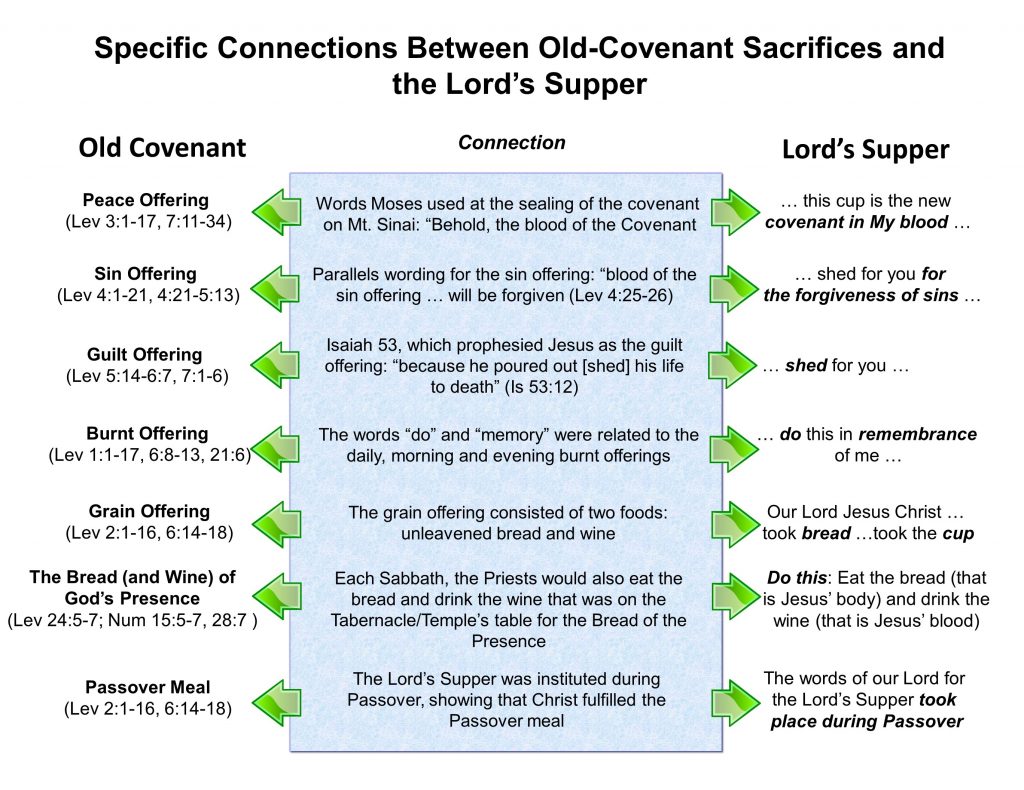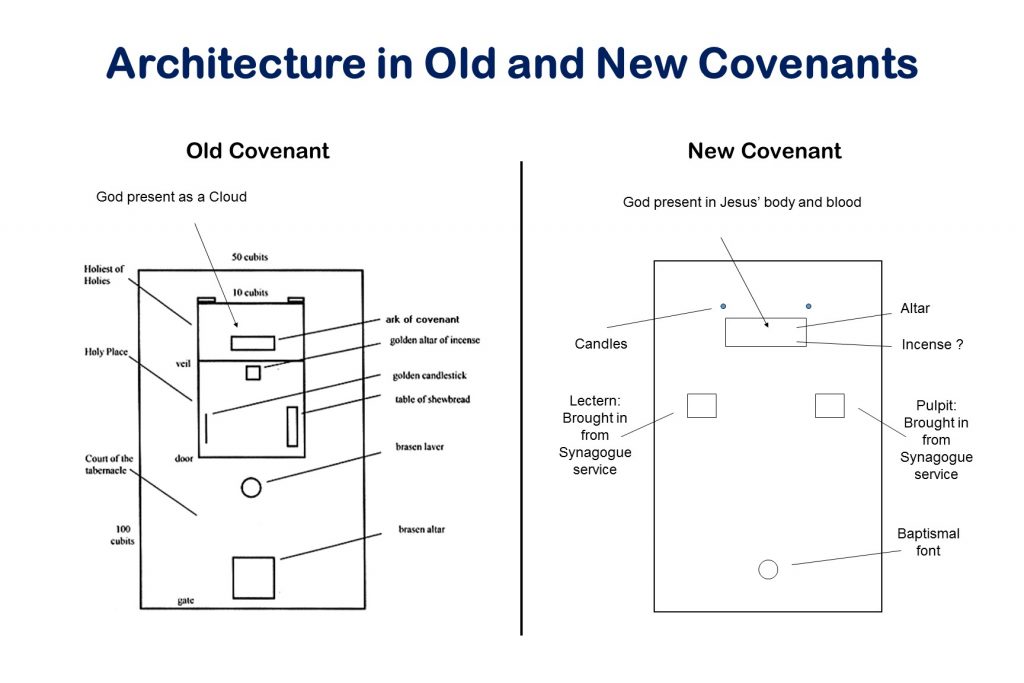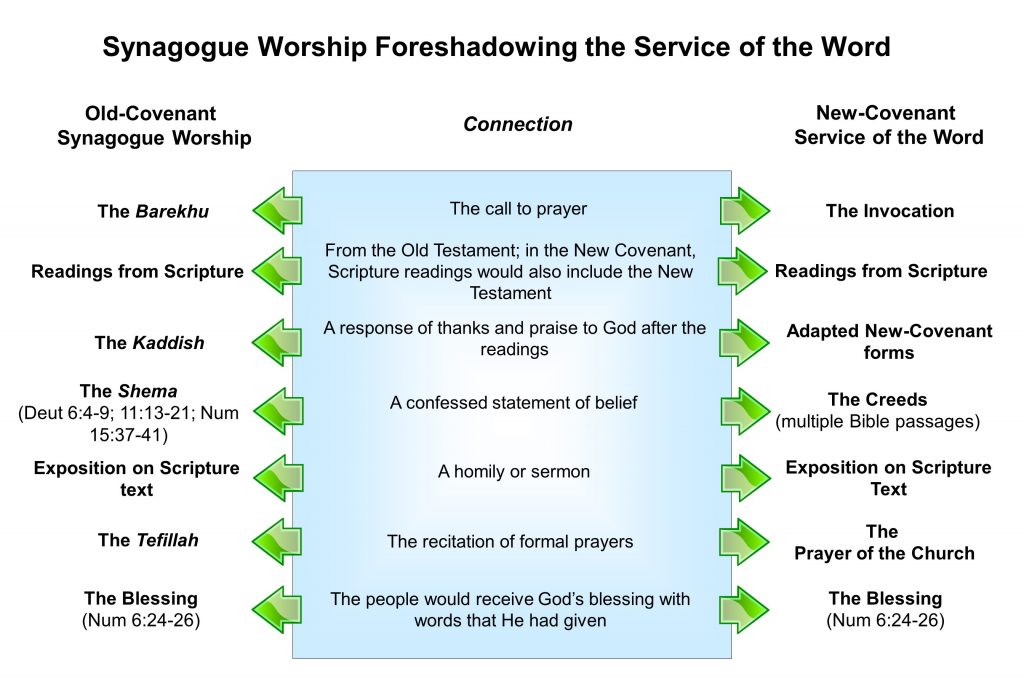 This lesson is part of individualized instruction in adult catechesis. A deeper understanding of the origins of Christian worship and how it developed was desired. Here it is.
This lesson is part of individualized instruction in adult catechesis. A deeper understanding of the origins of Christian worship and how it developed was desired. Here it is.
Cultural Assumptions in Worship
Today, many in the Church assume if God doesn’t forbid something, we may incorporate such a practice into worship. Such a view is the wrong starting point. Our understanding of worship should not begin with  the worshiper and his preferences but God and His “preferences” for us.
the worshiper and his preferences but God and His “preferences” for us.
The solution to this worldview is to the press the reset button and learn how God expected His people to worship from the beginning.
Worship during the time of the Tabernacle
When God brought Israel out of Egypt, He told them how they were to worship Him and how He would come to them. “Wherever I cause my name to be remembered, I will come to you and bless you” (Exodus 20:24). He instructed them on the Passover and the Festival of Unleavened Bread. Both were statutes, God-ordained rituals, which God’s people were to keep “forever” (Exodus 12:14, 17, and 24).
Exodus 24 through 30 and the book of Leviticus describe how God told and expected His people to worship. Much of what God gave was in thorough detail. God also said that those worship forms and ways were to be enduring, even forever (For example, we find this in Exodus 27:21, 28:43, 29:9, 30:21, 31:17, not even looking at the passages in Leviticus).
God chose the worship forms for the Israelites. When the Israelites chose how they wanted to worship God, such as through the golden calf (see Exodus 32:5), God was not pleased. Later, Moses told the Israelites: “You are not to worship as we are doing here today, everyone doing whatever seems right in his own eyes” (Deuteronomy 12:8). The worship of God has never been one of personal preference but, instead, based on God’s “preferences” for us.
Tabernacle/Temple worship in the New Covenant
The sacrifices at the Tabernacle/Temple in the Old Covenant foreshadowed Jesus’ sacrifice for the sins of the world. Jesus said, referring to Himself, “Destroy this Temple, and I will raise it again in three days” (John 2:19), revealing He would fulfill what took place in God’s Old-Covenant Temple. Those Temple sacrifices also foreshadowed the New Covenant, the Lord’s Supper, which Jesus would put in place as the fulfillment of the Old:
[Jesus] took bread, gave thanks, broke it, gave it to them, and said, “This is my body given for you. Do this in remembrance of me.” In the same way, he took the cup after supper and said, “This cup that is poured out for you is the new covenant in my blood.” [Luke 22:19-20]
The sacrifices of the Old Covenant brought to the people the benefit of Christ’s work before it was done. The Lord’s Supper of the New Covenant brings to us the benefit of Christ’s forgiveness after it was finished. (An excellent resource on this topic is Eating God’s Sacrifice by David J. Brege.)
The architecture of the Tabernacle still influences Church architecture to this day
In the original Tabernacle, the people’s focus was on the Holy Place and the Most-Holy Place (the Holy of Holies). The people would gather in the courtyard and outside of it, but their focus was on God’s presence above the Ark of the Covenant and the forgiveness of sins He delivered through the sacrifices on the altar.
Although in Old-Covenant worship, music, instruments, and choirs had a role, they were never the focus. The musicians did not move the Holy of Holies from its central location so they could be the focus and “lead” worship. Instead, they were part of the congregation’s response of praise back to God.
In the New Covenant, the Altar replaces the Ark of the Covenant in the Holy of Holies. The Altar is where God now makes His presence known to us in Jesus’ body and blood. The Chancel becomes the Holy Place. And the courtyard becomes the place where the people gather to receive the forgiveness of sins (just as they did in the Old Covenant), and respond back to God with prayer, praise, and thanksgiving (just as they did in the Old Covenant).
Just as the “center of gravity” was the Holy of Holies in the Old Covenant, so is the Altar the “center of gravity” in the New Covenant. For in the Lord’s Supper, Jesus fulfills what took place in the Tabernacle and Temple.
The development of Synagogue worship
In Exodus 34, even before the Tabernacle was built, God told the people of Israel:
Observe the Festival of Weeks, the Firstfruits of the Wheat Harvest, and the Festival of the Final Harvest at the end of the season. Three times a year all your males are to appear before Yahweh God, the God of Israel.” [Exodus 34:22-23]
God commanded the Israelites to observe three festivals at the Tabernacle/Temple even before the Tabernacle was built. Why? God was pointing forward to a time when going to the Tabernacle/Temple every Sabbath would become impossible for many Israelites because of geographical distance. For those in such a situation, they came to those three festivals. In other words, God was presupposing the development of synagogue worship away from the Tabernacle/Temple.
God said, “You may work for six days, but the seventh day is a day of Sabbath rest, a day of sacred assembly. Do not do any work; wherever you live, it is a Sabbath to the Lord” (Leviticus 23:3).
Every Sabbath was a day of rest, but many Israelites lived too far away from the Tabernacle/Temple to be there every Sabbath. For such Sabbath worship to take place, geographical places of worship had to develop wherever they lived—the synagogue.
Psalm 74 mentions both the Temple and synagogue. Referring to enemies destroying the places where the one, true God was worshiped, it reads:
Your enemies … set your sanctuary on fire; they defiled the dwelling place of your name [the Temple]. They said to themselves, “We will crush them completely!” They burned every meeting place of God [synagogue] in the land. [Psalm 74:4, 7-8]
Synagogue worship did not replace the Temple but was an alternate location of worship for those who could not make it to the Temple. To reflect the supporting purpose of those synagogues, they:
- were built facing toward Jerusalem,
- contained an “ark” in which was stored the scrolls of the Torah, and
- included a raised area, symbolizing the Tabernacle/Temple within the courtyard, from which the elders and/or rabbis conducted the service and taught/preached.
Those designs incorporated from the Temple were to remind the Israelites that Temple worship was the primary, God-instituted form and place for worship, with the synagogue being a later development to support the worship at the Temple.
The Synagogue also foreshadowed New-Covenant worship
Although synagogue worship was a development within the Jewish tradition of remembering the Sabbath day to keep it holy, Jesus fully recognized and approved of synagogue worship (Matthew 4:23; Matthew 9:35, Mark 1:21, Luke 4:16).
These two elements of Jewish worship—synagogue and Temple—formed the basic components of the form or order of the liturgy for the early Christian Church. In their fulfilled forms, synagogue worship became the “Service of the Word” and Tabernacle/Temple worship and its sacrifices became the “Service of the Sacrament.”
However, just as synagogue worship existed to support Temple worship, not replace it, so also does the “Service of the Word” exist to support the “Service of the Sacrament.”




